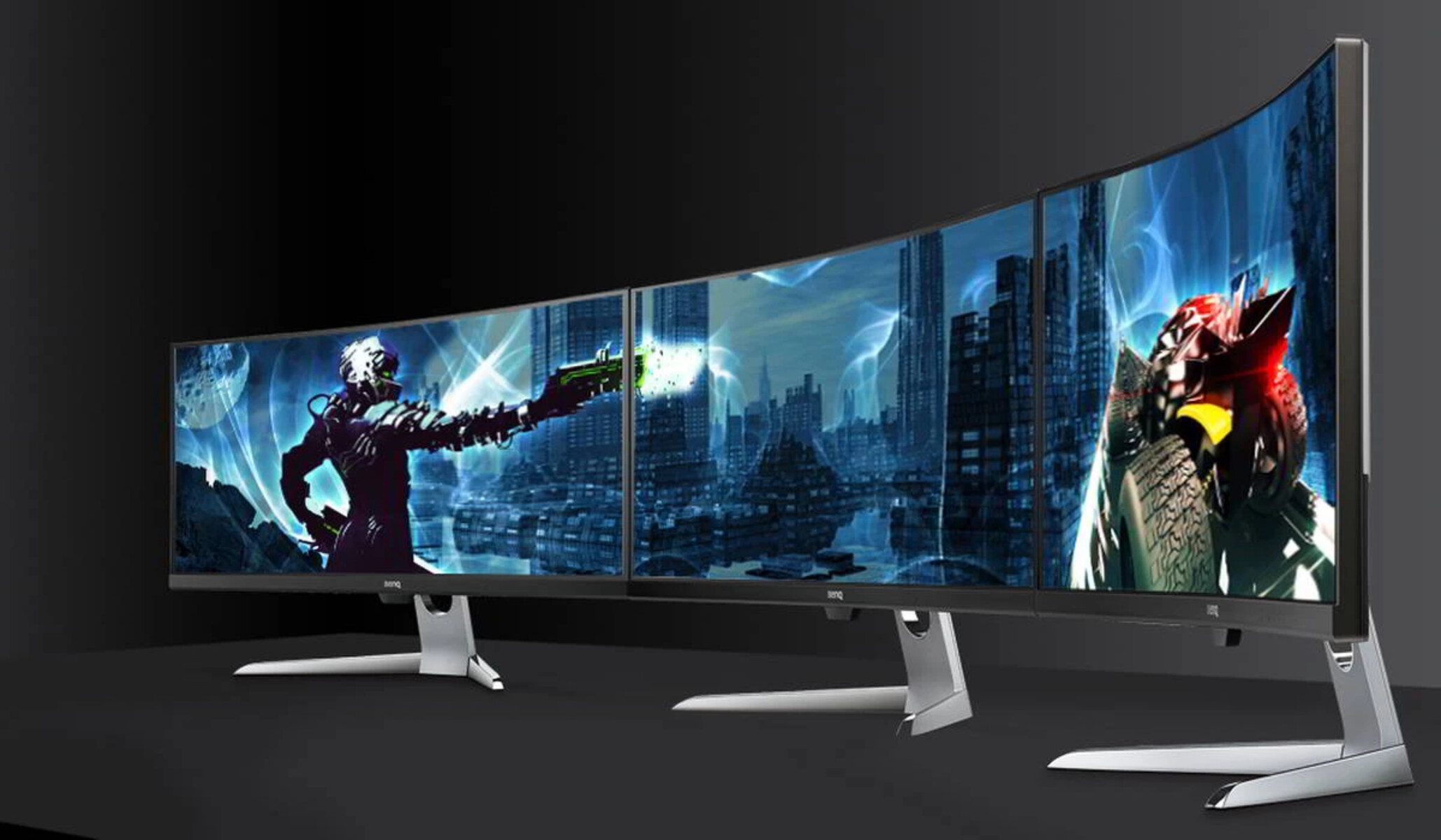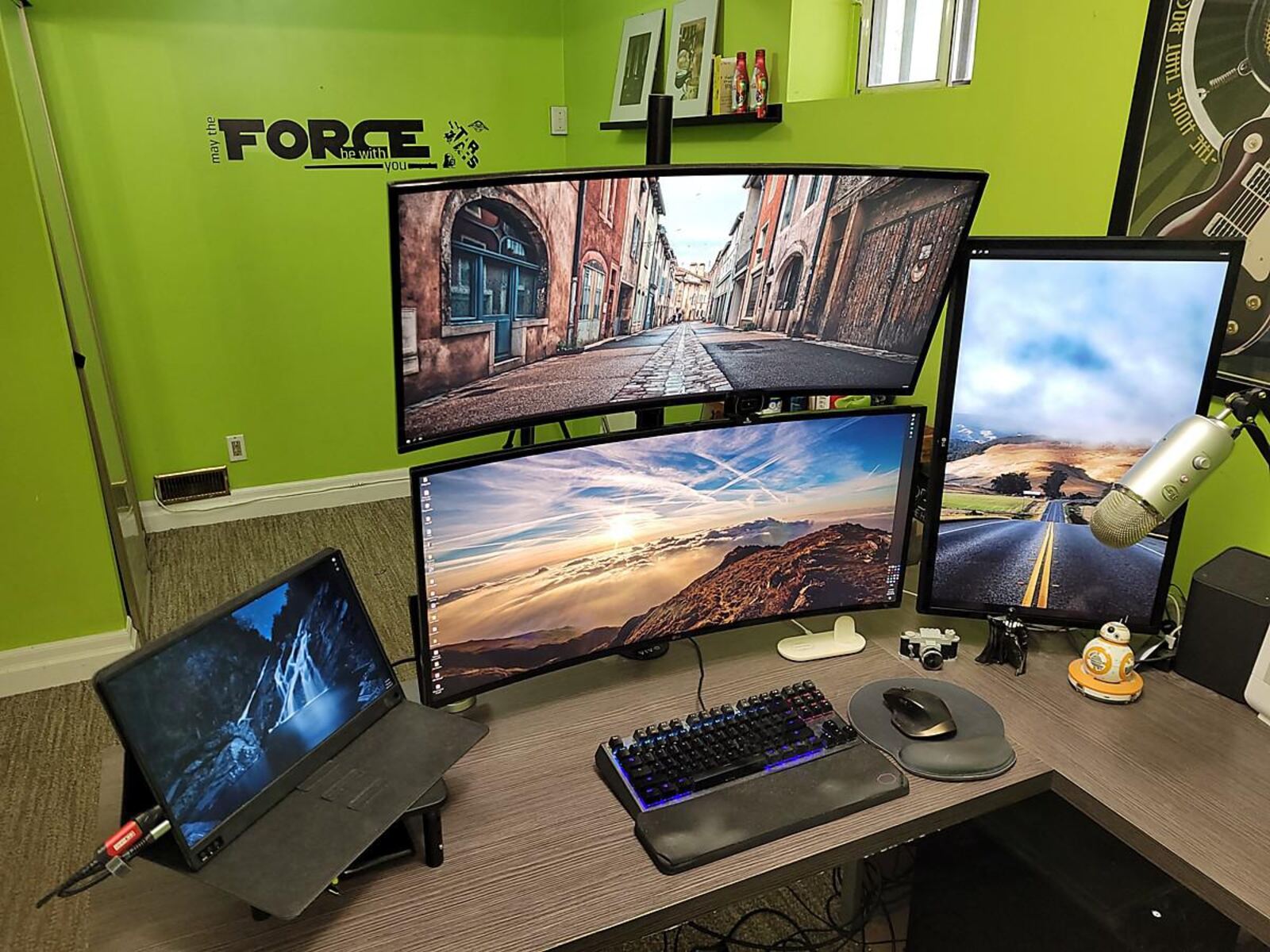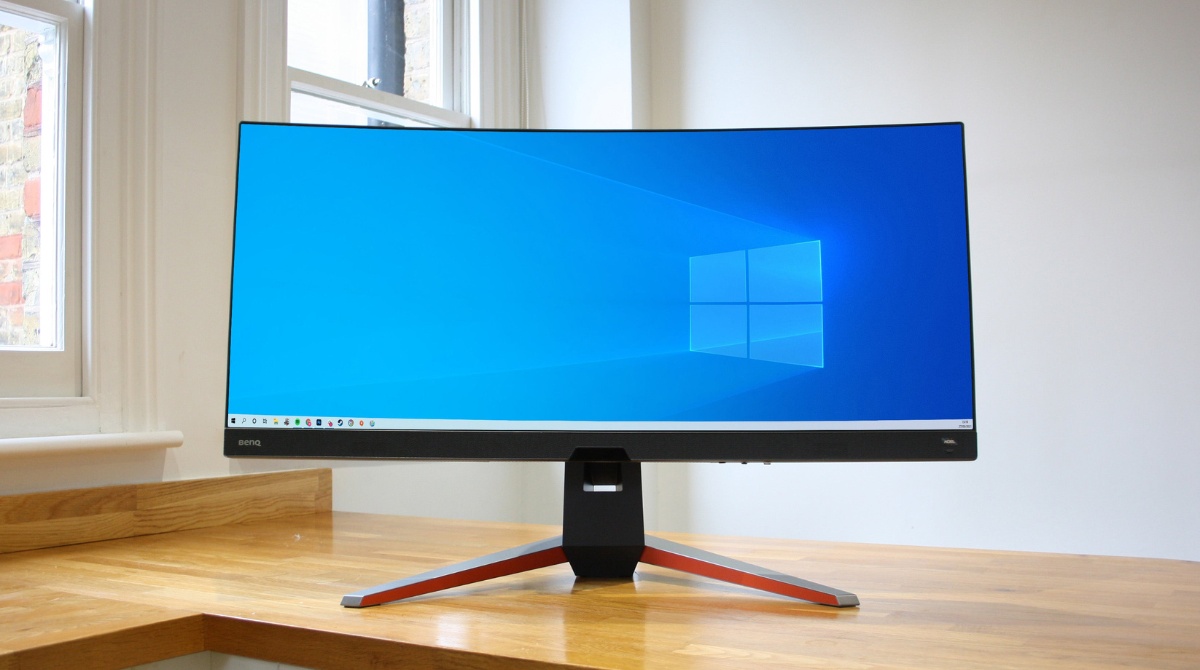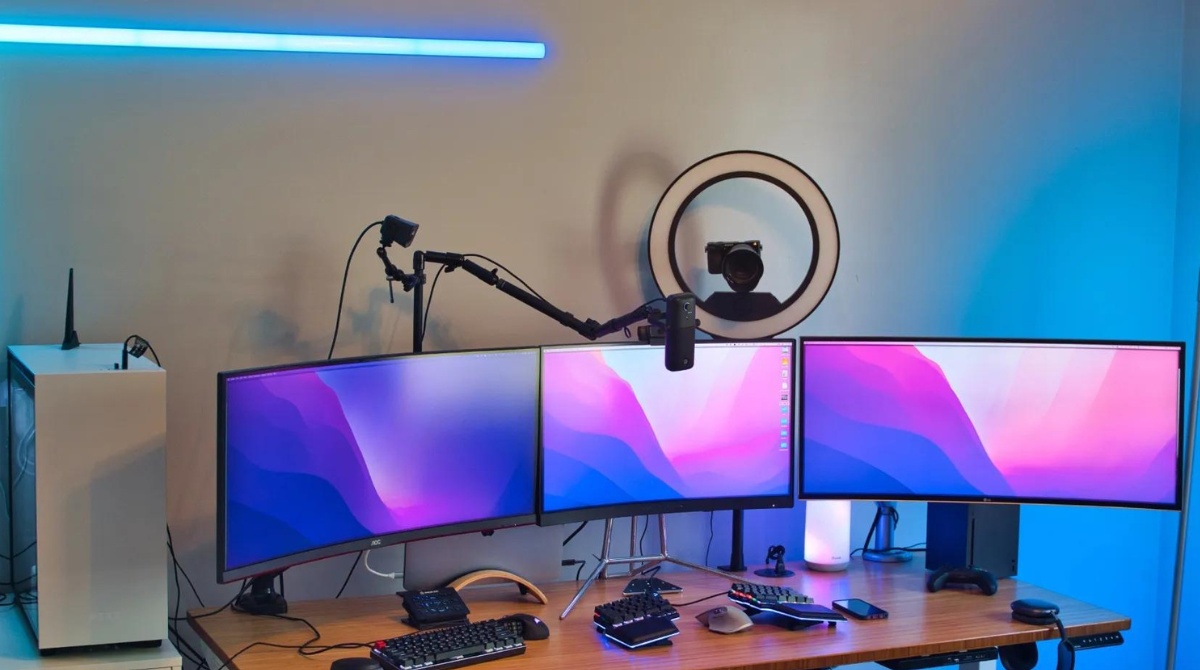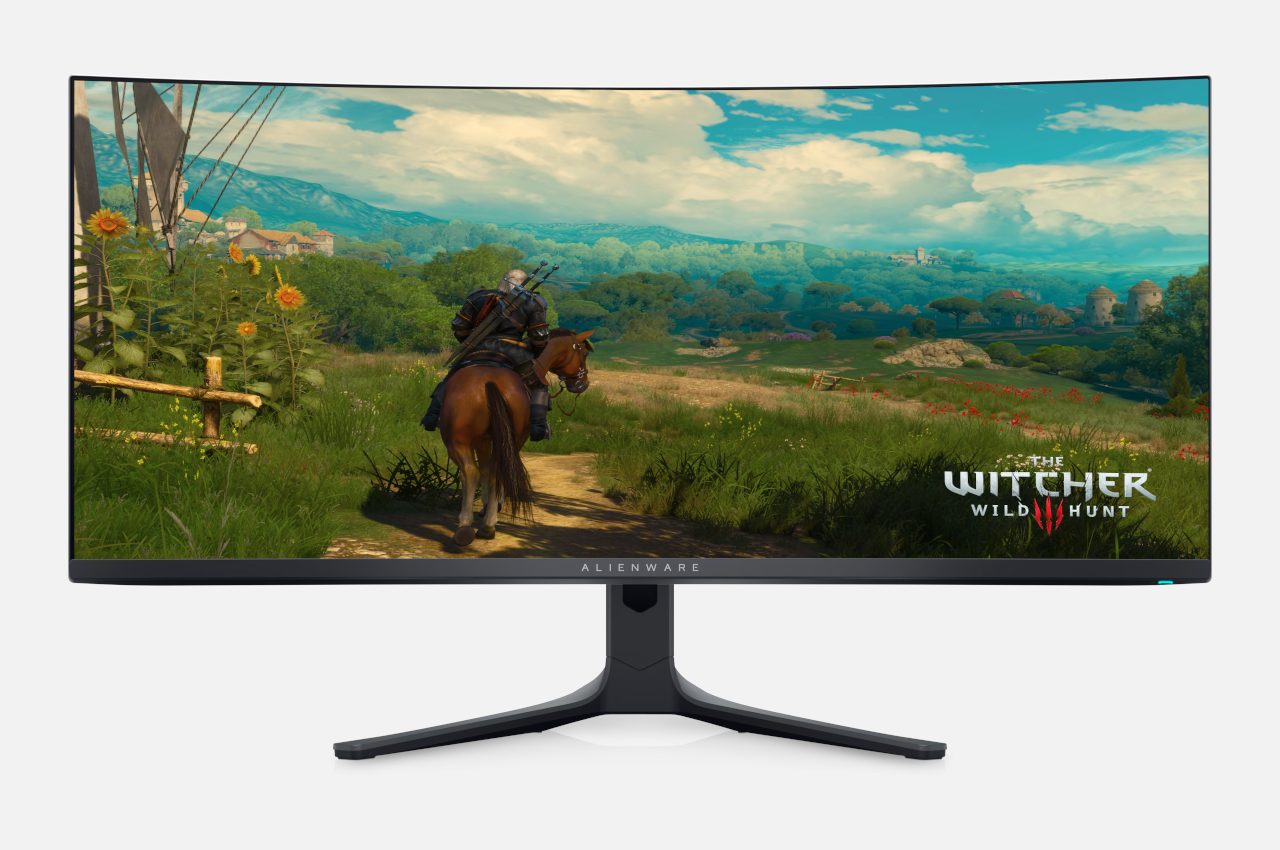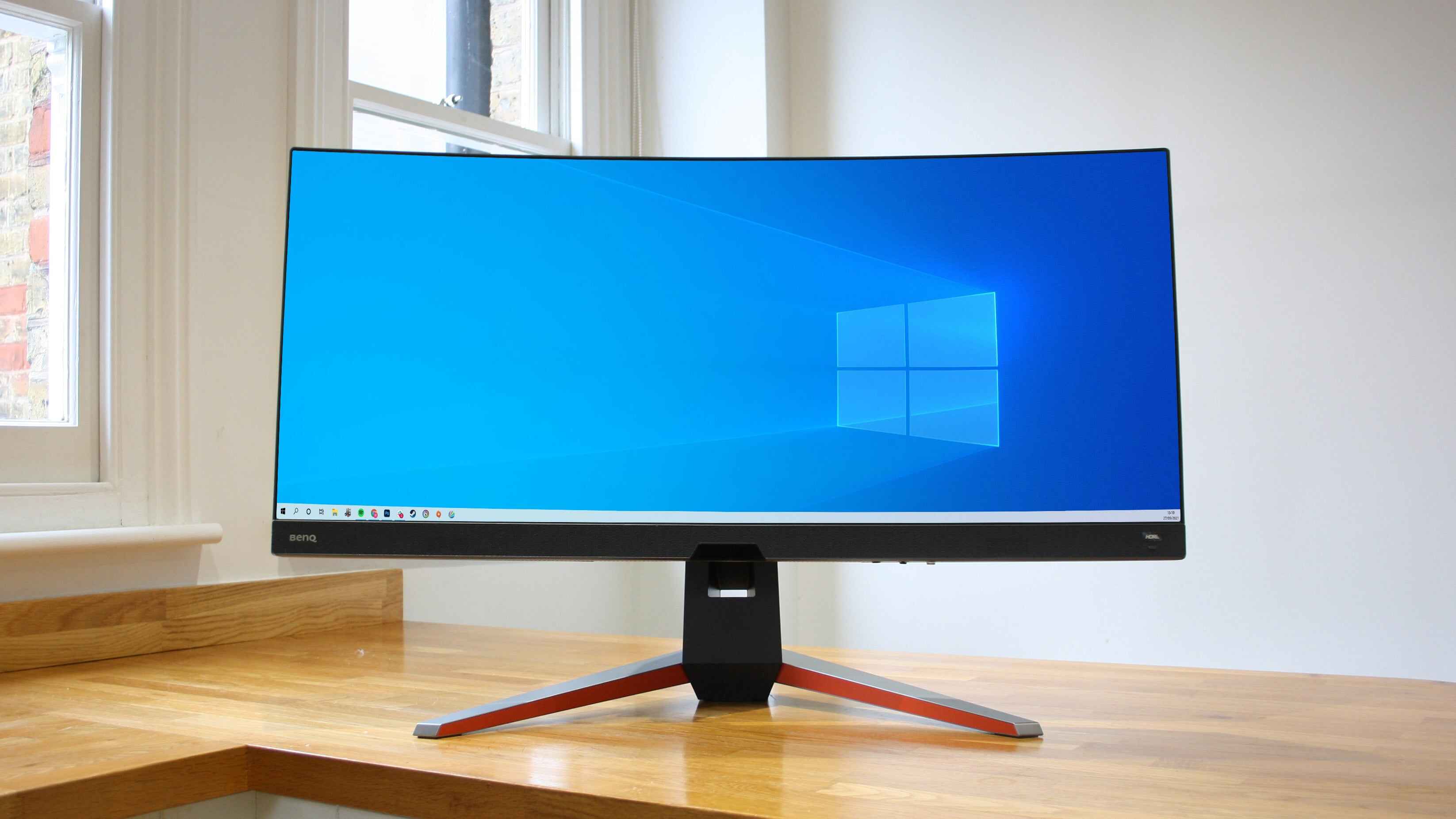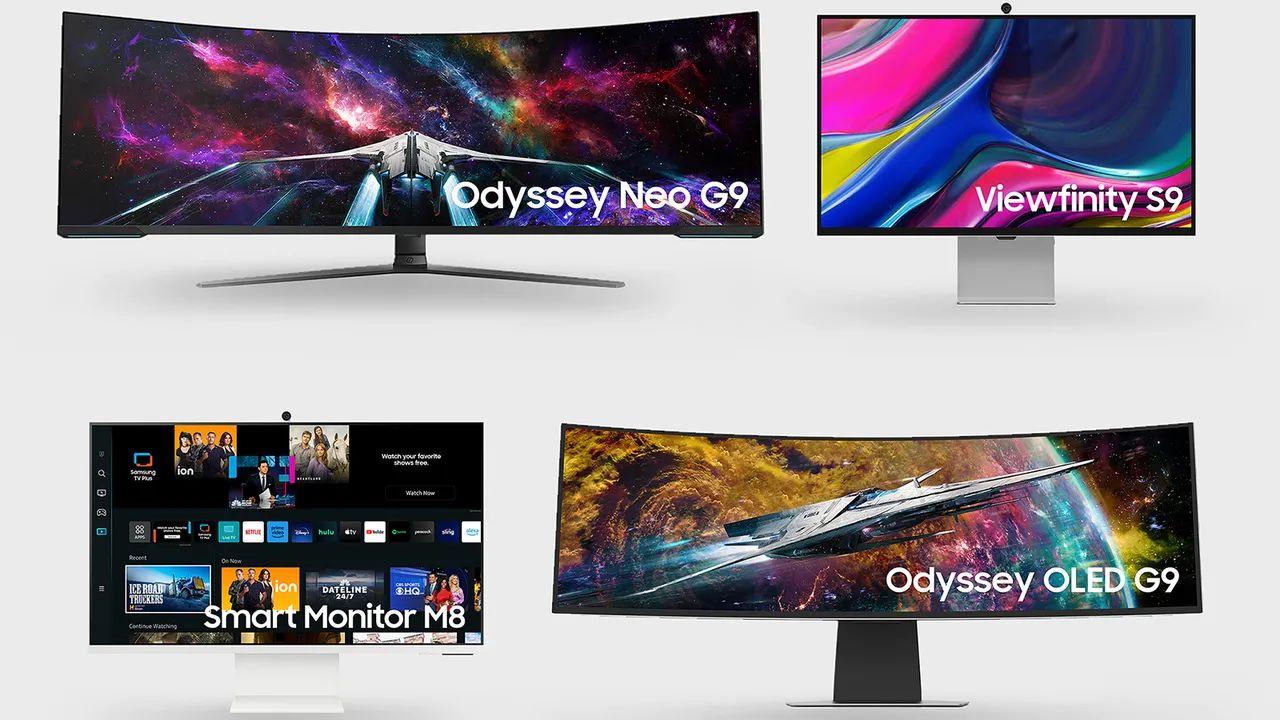Introduction
Gaming monitors have come a long way since their inception, and one of the most sought-after options in recent years is the ultrawide gaming monitor. Designed to offer a more immersive gaming experience, these wider displays provide a wider field of view, allowing gamers to see more of the game world without the distraction of bezels in the middle. Whether you’re a casual gamer or a serious esports enthusiast, investing in the best ultrawide gaming monitor can greatly enhance your gaming experience.
But with so many options available in the market, choosing the right ultrawide gaming monitor can be a daunting task. There are several factors to consider, including resolution, aspect ratio, refresh rate, response time, panel technology, HDR support, connectivity options, and additional features. Each of these factors plays a crucial role in determining the overall gaming experience and the visual quality of the games.
In this article, we will delve into the world of ultrawide gaming monitors, discussing the various factors you need to consider when choosing one. We will cover the different aspects of ultrawide gaming monitors, from their resolutions and aspect ratios to their response times and panel technologies. Additionally, we will explore the differences between curved and flat ultrawide monitors and discuss the importance of factors like HDR support, color accuracy, and connectivity options. Whether you’re on a budget or looking for a high-end option, we’ll also provide recommendations for the best ultrawide gaming monitors in different price ranges.
So, whether you’re a competitive gamer seeking an edge or just someone who enjoys getting lost in the immersive worlds of your favorite games, read on to discover more about ultrawide gaming monitors and find the perfect one that meets your gaming needs and budget.
What is an Ultrawide Gaming Monitor?
An ultrawide gaming monitor is a display that offers a wider aspect ratio than the standard 16:9 aspect ratio found in most traditional monitors. While a standard monitor typically has a width-to-height ratio of 16:9, ultrawide monitors have a wider aspect ratio, usually ranging from 21:9 to 32:9. This wider screen allows for a more immersive gaming experience by expanding the field of view and eliminating the need for multiple monitors or bezels in the middle of the screen.
Ultrawide gaming monitors come in various sizes, typically starting from 29 inches and going all the way up to 49 inches. These larger screens provide gamers with a wider panoramic view, allowing them to see more of the game world and enhancing their peripheral vision. This added real estate is particularly beneficial for genres like first-person shooters, racing games, and strategy games, where a wider field of view can give players a competitive edge.
Most ultrawide gaming monitors also feature a curved design, which further enhances the immersive experience by wrapping the screen around the player’s field of view. The curved design creates a more natural viewing angle, reducing eye strain and creating a more immersive and engaging visual experience. The curvature of the screen can vary between monitors, with some having a more subtle curve while others employ a more pronounced curve.
When it comes to resolution, ultrawide gaming monitors usually offer a higher pixel count compared to standard monitors. The most common resolution for ultrawide monitors is 3440×1440 (WQHD), while some high-end models even offer 3840×1600 (UWQHD) or 5120×1440 (Super Ultrawide) resolutions. These higher resolutions result in sharper and more detailed visuals, bringing the game world to life with stunning clarity.
In addition to the wider aspect ratio and higher resolutions, ultrawide gaming monitors often boast a high refresh rate and low response time. A high refresh rate, typically 144Hz or higher, ensures smoother gameplay with reduced motion blur, giving gamers a competitive advantage. Combined with a low response time, usually around 1ms or less, these monitors can provide ultra-responsive gameplay, making them ideal for fast-paced action games.
Overall, ultrawide gaming monitors offer a unique and immersive gaming experience, thanks to their wider aspect ratio, larger screen size, curved design, and high-resolution displays. Whether you’re a professional gamer, a content creator, or simply a gaming enthusiast, investing in an ultrawide gaming monitor can take your gaming experience to new heights, providing a wider, more immersive view of the virtual worlds you love to explore and conquer.
Factors to Consider When Choosing an Ultrawide Gaming Monitor
Choosing the right ultrawide gaming monitor can greatly enhance your gaming experience. However, with the multitude of options available in the market, it’s important to consider several factors before making your decision. Here are some key factors to keep in mind:
- Resolution and Aspect Ratio: Ultrawide monitors come in various resolutions, such as 3440×1440, 3840×1600, or 5120×1440. Higher resolution screens offer sharper and more detailed visuals, but also require more powerful hardware to drive them. Additionally, consider the aspect ratio, with 21:9 being the most common for ultrawide monitors.
- Refresh Rate and Response Time: A high refresh rate, usually 144Hz or higher, ensures smoother gameplay with reduced motion blur. Look for a low response time, around 1ms or less, to minimize input lag and ghosting, especially for fast-paced games.
- Curved vs Flat Ultrawide Gaming Monitors: Consider whether you prefer a curved or flat design. Curved monitors provide a more immersive experience by wrapping around your field of view, while flat monitors offer a more traditional display.
- Panel Technology: Ultrawide gaming monitors use various panel technologies, including VA, IPS, and TN. VA panels offer deep blacks and high contrast ratios, IPS panels provide accurate colors and wide viewing angles, while TN panels offer fast response times and high refresh rates.
- HDR (High Dynamic Range) and Color Accuracy: If you value stunning visuals, look for an ultrawide monitor with HDR support. HDR enhances color contrast and provides a wider range of colors for a more vivid and realistic image. Additionally, consider the color accuracy of the monitor, especially if you’re a content creator or enjoy photo editing.
- G-Sync vs FreeSync: Consider whether you prefer NVIDIA G-Sync or AMD FreeSync technology. G-Sync and FreeSync help to synchronize the monitor’s refresh rate with your graphics card, reducing screen tearing and providing smoother gameplay. Note that G-Sync monitors are compatible with NVIDIA GPUs, while FreeSync monitors work with AMD GPUs.
- Connectivity and Additional Features: Check the connectivity options of the monitor, such as HDMI, DisplayPort, or USB Type-C. Additionally, consider any additional features like built-in speakers, USB ports, or ergonomic adjustments like tilt, swivel, and height adjustment.
It’s essential to assess your specific gaming needs, preferences, and budget when considering these factors. Keep in mind that while high-end monitors offer top-of-the-line features and technologies, there are also budget-friendly options that provide excellent gaming experiences without breaking the bank. By carefully evaluating these factors, you can select the perfect ultrawide gaming monitor that suits your gaming style, enhances your visuals, and improves your overall gaming experience.
Resolution and Aspect Ratio
When choosing an ultrawide gaming monitor, one of the key considerations is the resolution and aspect ratio. The resolution determines the number of pixels on the screen, while the aspect ratio refers to the width-to-height ratio of the display. These factors play a crucial role in the visual quality and immersion of your gaming experience.
The most common resolution for ultrawide monitors is 3440×1440, also known as WQHD or 2K. This resolution provides a sharp and detailed image, making it an excellent choice for most gamers. However, if you’re looking for even higher resolution, there are models available with resolutions of 3840×1600 (UWQHD) and 5120×1440 (Super Ultrawide). These higher resolutions offer an even more immersive visual experience with breathtakingly crisp details.
It’s important to note that higher resolutions require more powerful hardware to drive them effectively. Ensure that your graphics card can handle the increased pixel count to avoid compromising on performance. For those who prefer a smoother gaming experience, lower resolutions may be a more suitable option, as they place less strain on your system and allow for higher frame rates.
In addition to resolution, the aspect ratio is a crucial consideration when choosing an ultrawide gaming monitor. The most common aspect ratio for ultrawide monitors is 21:9, which offers a wider field of view compared to traditional 16:9 displays. This wider aspect ratio provides a more immersive experience, allowing you to see more of the game world without the distraction of bezels in the middle.
One thing to keep in mind is that not all games support the ultrawide aspect ratio. While most modern games have native support, some older titles or niche games may have limited compatibility. In these cases, you may experience black bars on the sides of the screen or stretched visuals. However, many gaming communities and software solutions exist that can help overcome these limitations and provide a better gaming experience on ultrawide displays.
Overall, the resolution and aspect ratio of an ultrawide gaming monitor are significant factors in determining the visual quality and immersion of your gaming experience. Higher resolutions offer a sharper and more detailed image, while a wider aspect ratio expands your field of view, enhancing the overall gaming experience. Consider your hardware capabilities, desired visual quality, and game compatibility when making a decision on the resolution and aspect ratio that best suits your gaming needs.
Refresh Rate and Response Time
When it comes to gaming, having a high refresh rate and low response time is crucial for achieving smooth and responsive gameplay. These factors play a significant role in reducing motion blur, input lag, and ghosting, ensuring a more immersive and enjoyable gaming experience.
The refresh rate of a monitor refers to the number of times the image on the screen is refreshed per second and is measured in Hertz (Hz). A higher refresh rate results in smoother motion, providing more fluid gameplay and reducing motion blur. The standard refresh rate for gaming monitors is typically 60Hz. However, for a more responsive and immersive experience, it is recommended to consider monitors with refresh rates of 144Hz or higher.
Higher refresh rates allow for quicker updates to the on-screen image, resulting in smoother transitions between frames. This is particularly beneficial for fast-paced games, such as first-person shooters or racing games, where precise and quick movements can make a significant difference in gameplay. Additionally, a higher refresh rate can make the overall gaming experience more visually pleasing, providing a more lifelike and realistic representation of in-game action.
Response time is another important factor to consider when selecting an ultrawide gaming monitor. It measures how quickly the pixels can change from one color to another. A lower response time means faster pixel transitions and reduces the amount of motion blur in fast-moving scenes. Most gaming monitors have a response time of 1ms or less, ensuring minimal input lag and smooth transitions between frames.
Reducing motion blur and input lag is crucial for competitive gaming, as it can provide a significant advantage in reaction time. It allows you to see and respond to in-game actions faster, giving you a more competitive edge over your opponents. However, it’s worth noting that achieving extremely low response times may come at the cost of color accuracy or viewing angles, as certain panel technologies prioritize speed over other aspects.
When selecting an ultrawide gaming monitor, it’s important to find a balance between refresh rate, response time, and other factors. Consider the types of games you play and your gaming preferences to determine the ideal refresh rate and response time for your needs. Remember, a higher refresh rate and lower response time can enhance your gaming experience, particularly for fast-paced games, and contribute to smoother, more responsive gameplay.
Curved vs Flat Ultrawide Gaming Monitors
When choosing an ultrawide gaming monitor, one consideration to keep in mind is whether you prefer a curved or flat design. Both options have their advantages, and the choice ultimately comes down to personal preference and the type of gaming experience you’re looking for.
Curved ultrawide gaming monitors have become increasingly popular in recent years, thanks to their ability to provide a more immersive gaming experience. The curved screen design helps to wrap the display around your field of view, creating a more natural and panoramic viewing angle. This curvature enhances your peripheral vision, making you feel more engaged and involved in the game world. It creates a sense of depth and immersion, drawing you into the gameplay and making it more visually captivating.
Flat ultrawide gaming monitors, on the other hand, offer a more traditional display design. They have a flat screen surface, similar to standard monitors, without any curvature. While they may not offer the same level of immersion as curved monitors, they still provide a wide field of view and can be a more practical choice for certain setups and preferences. Flat monitors are often more affordable and have a wider variety of options available, making them a more budget-friendly choice for gamers.
When deciding between curved and flat ultrawide gaming monitors, it’s important to consider your gaming preferences and the setup of your gaming space. If you value a highly immersive experience and enjoy games with stunning visuals and wide open spaces, a curved monitor may be the ideal choice for you. The curved design can enhance the depth and realism of the game world, making it feel more expansive.
On the other hand, if you prefer a more traditional display and prioritize practicality and cost-effectiveness, a flat ultrawide monitor might be a better fit. Flat monitors are often easier to mount on a wall or adjust on a desk, and their wider availability means you can find options that cater to your specific needs, whether it be a lower price point or specific features.
Ultimately, the choice between a curved and flat ultrawide gaming monitor depends on your personal preference and gaming style. Consider factors such as cost, immersion, practicality, and the types of games you play when making your decision. Both options have their merits, and either choice can provide an exceptional gaming experience. Opt for the design that aligns with your preferences and enhances your enjoyment of gaming.
Panel Technology: VA vs IPS vs TN
When choosing an ultrawide gaming monitor, it’s important to consider the panel technology used in the display. The panel technology directly affects the visual quality, color accuracy, viewing angles, and response times of the monitor. The three most common panel technologies used in gaming monitors are VA (Vertical Alignment), IPS (In-Plane Switching), and TN (Twisted Nematic).
VA panels are known for their high contrast ratios, providing deep blacks and rich colors. They offer excellent color reproduction and can display a wide range of colors, making them ideal for content creators or gamers who prioritize color accuracy. VA panels also have good viewing angles, ensuring that the color and image quality remains consistent from different angles. However, VA panels may have slightly slower response times compared to other panel types, which can result in some motion blur in fast-paced games.
IPS panels are renowned for their excellent color accuracy and wide viewing angles. They produce vibrant and accurate colors, making them a popular choice for gamers and graphic designers who require precise color reproduction. IPS panels also offer quick response times, reducing motion blur and ghosting during fast-moving scenes. Their wide viewing angles ensure that the image remains consistent and accurate, even when viewed from different angles. However, IPS panels typically have a slightly higher price tag compared to other panel technologies.
TN panels are known for their fast response times and high refresh rates, making them a popular choice among competitive gamers. They offer extremely low response times, ensuring minimal input lag and enabling smooth, responsive gameplay. TN panels also excel in terms of refresh rates, with options available for high refresh rates up to 240Hz. However, TN panels generally have lower color accuracy and narrower viewing angles compared to VA and IPS panels, making them less suitable for tasks that require precise color reproduction or viewing from non-ideal angles.
When choosing between VA, IPS, and TN panels, consider your specific needs and preferences. If you prioritize color accuracy and wider viewing angles, an IPS panel may be the best choice. If deep blacks and high contrast ratios are important to you, a VA panel might be more suitable. If you’re a competitive gamer and value fast response times and high refresh rates, a TN panel could be the optimal option.
It’s worth noting that advancements in panel technology have led to improvements in performance and mitigated some of the traditional drawbacks. For example, certain VA panels now offer faster response times, and IPS panels have made strides in achieving higher refresh rates. It’s essential to read reviews and consider the specific model’s performance and specifications when evaluating the panel technology.
Ultimately, the choice of panel technology will depend on your individual preferences, budget, and specific gaming needs. Consider the trade-offs between color accuracy, response times, viewing angles, and price to find the panel technology that offers the best balance for your ultrawide gaming monitor.
HDR (High Dynamic Range) and Color Accuracy
When selecting an ultrawide gaming monitor, considering factors such as HDR (High Dynamic Range) support and color accuracy can significantly impact your gaming experience. These features contribute to more vibrant and lifelike visuals, enhancing the overall immersion in your games.
HDR, or High Dynamic Range, expands the range of colors, contrast, and brightness that a monitor can display. It allows for more accurate and realistic reproduction of colors, resulting in a more immersive and visually stunning gaming experience. HDR introduces a more extensive color gamut, providing a wider range of colors and shades, including deeper blacks and brighter whites.
Monitors with HDR support can deliver a broader spectrum of colors, allowing for more vivid and detailed visuals. This is particularly beneficial for games that are designed with HDR in mind, as it brings out the full potential of the game’s graphics and adds depth to the image. HDR can enhance the realism of the game world, making it feel more vibrant and true-to-life.
Another aspect to consider is color accuracy. Accurate color representation ensures that the colors you see on the screen closely match the intended colors. A monitor with good color accuracy displays colors as they were intended to be viewed, allowing you to experience games and other content as the developers intended. This is crucial for graphic designers, content creators, and gamers who value precise color reproduction.
IPS panels are generally known for their excellent color accuracy, as they provide more accurate and consistent colors across the entire screen. Their wide viewing angles also help maintain color accuracy even when viewed from different angles. However, it’s worth noting that color accuracy can vary between individual monitors, even within the same panel technology. Reading reviews and conducting research on the specific model can help you determine its color accuracy performance.
When choosing an ultrawide gaming monitor, consider whether HDR support and color accuracy are essential for your needs. If you value visually stunning and immersive gameplay experiences, opting for a monitor with HDR support can greatly enhance your gaming experience. Additionally, if accurate color reproduction is a priority, selecting a monitor with good color accuracy, particularly one with an IPS panel, can ensure that the colors display as intended.
Keep in mind that to experience the benefits of HDR and accurate colors, you should ensure that your games and other content are actually HDR-compatible and that you have sufficient HDR-enabled hardware to take advantage of these features. While HDR and color accuracy can significantly enhance your gaming visuals, always balance these factors with other considerations such as budget, panel technology, and gaming requirements to find the best ultrawide gaming monitor for your needs.
G-Sync vs FreeSync: Which is Better for Gaming?
When looking for an ultrawide gaming monitor, you’ll often come across the terms G-Sync and FreeSync, which are variable refresh rate (VRR) technologies developed by NVIDIA and AMD, respectively. These technologies are designed to eliminate screen tearing, stuttering, and input lag, providing a smoother and more immersive gaming experience. While both G-Sync and FreeSync offer similar benefits, there are some differences to consider when choosing between them.
G-Sync, developed by NVIDIA, is a VRR technology that requires the use of NVIDIA GPUs. G-Sync monitors utilize a specialized hardware module to synchronize the monitor’s refresh rate with the GPU’s frame rate, eliminating screen tearing and minimizing stuttering. The module allows for a variable refresh rate range, providing smooth gameplay even when the frame rate fluctuates. G-Sync monitors tend to provide a consistent and stable gaming experience, with excellent image quality and minimal input lag.
On the other hand, FreeSync, developed by AMD, is an open standard VRR technology that is compatible with AMD GPUs. Unlike G-Sync, FreeSync does not require a specialized hardware module, making FreeSync monitors generally more affordable compared to G-Sync monitors. FreeSync monitors use the Adaptive Sync feature of the DisplayPort standard to dynamically adjust the monitor’s refresh rate based on the GPU’s frame rate. This synchronization eliminates screen tearing and stuttering while maintaining low input lag.
In terms of performance, both G-Sync and FreeSync offer a similar VRR experience, effectively eliminating screen tearing and providing a smoother gameplay experience. However, since NVIDIA G-Sync monitors have a proprietary hardware module, they typically have a higher price point compared to FreeSync monitors.
When deciding between G-Sync and FreeSync, it often comes down to your GPU choice. If you have an NVIDIA GPU, G-Sync would be the compatible option. Similarly, if you have an AMD GPU, FreeSync would be the compatible option. However, it’s worth noting that NVIDIA has made some of their newer graphics cards compatible with FreeSync monitors, expanding the options for gamers who have NVIDIA GPUs.
Ultimately, the choice between G-Sync and FreeSync depends on your specific GPU and budget. If you have an NVIDIA GPU and can afford it, G-Sync offers a consistent and reliable VRR experience. However, if you have an AMD GPU or are looking for a more affordable option, FreeSync provides a cost-effective and viable solution. Regardless of which technology you choose, both G-Sync and FreeSync can greatly enhance your gaming visuals, ensuring a smoother and more enjoyable gaming experience.
Connectivity and Additional Features
When choosing an ultrawide gaming monitor, it’s important to consider the available connectivity options and additional features. These aspects can greatly enhance your gaming experience and offer convenience and versatility in your setup.
Connectivity options play a crucial role in ensuring that your monitor is compatible with your gaming system and other devices. Common connectivity ports to look for in an ultrawide gaming monitor include HDMI, DisplayPort, and USB Type-C. HDMI is widely used and supports both audio and video transmission. DisplayPort, often found in high-end monitors, offers higher bandwidth and better support for higher refresh rates and resolutions. USB Type-C is a versatile port that allows for data transfer, video output, and power delivery, making it a convenient option if you have compatible devices.
Consider the types and number of ports you require based on your gaming setup and the devices you plan to connect to your monitor. If you have multiple gaming consoles, PCs, or other peripherals, having ample connectivity options can ensure easy and seamless connections.
In addition to connectivity, consider the additional features offered by an ultrawide gaming monitor. Built-in speakers can be a convenient addition, providing audio output without the need for separate external speakers. While the sound quality may not match dedicated speakers, built-in speakers can be useful for casual gaming or when space is limited.
USB ports are also valuable additions to a gaming monitor, as they allow for easy connection and charging of peripherals such as mice, keyboards, or smartphones. USB hubs with multiple ports enable convenient connectivity of various devices, reducing the need for separate USB hubs on your desk.
Ergonomic adjustments are another aspect to consider. Make sure the monitor offers tilt, swivel, and height adjustment options, allowing you to find the most comfortable viewing position. Being able to adjust the monitor to your preferred position can help reduce strain on your neck and eyes during long gaming sessions.
Additional gaming-specific features, such as gaming presets, customizable profiles, or on-screen displays (OSD), can enhance your gaming experience further. These features allow you to adjust and optimize the monitor’s settings to suit your specific gaming needs, ensuring the best possible visuals and performance.
When choosing an ultrawide gaming monitor, carefully assess the connectivity options and additional features that align with your gaming requirements. Consider the devices you plan to connect, the convenience and flexibility you desire, and how the additional features can enhance your overall gaming experience. By selecting a monitor with the right connectivity and features, you can create a versatile and immersive gaming setup that meets your specific needs.
Budget-Friendly Options: Best Ultrawide Gaming Monitors Under $500
When searching for an ultrawide gaming monitor, budget can often be a deciding factor. Fortunately, there are several excellent options available under $500 that offer impressive features and performance without sacrificing quality. Here are some of the best budget-friendly ultrawide gaming monitors to consider:
- AOC CQ32G1: This 32-inch monitor offers a 1440p resolution and a 144Hz refresh rate, providing a stunning and smooth gaming experience. With its VA panel, it delivers excellent color reproduction and deep blacks. The monitor also features AMD FreeSync technology for tear-free gaming.
- LG 34UM69G-B: This 34-inch monitor offers a 2560×1080 resolution and a 75Hz refresh rate. It features an IPS panel, which provides accurate colors and wide viewing angles. The monitor also supports AMD FreeSync for smooth gaming and has a 1ms motion blur reduction feature.
- ViewSonic VX2458-C-MHD: This 24-inch curved monitor offers a 1080p resolution and a 144Hz refresh rate. It features a VA panel with excellent color reproduction and good contrast. The monitor also supports AMD FreeSync for tear-free gaming and has a 1ms response time for minimal input lag.
- MSI Optix MAG341CQ: This 34-inch monitor offers a 1440p resolution and a 100Hz refresh rate. It features a VA panel with vibrant colors and good contrast. The monitor also supports AMD FreeSync and has a curved design for enhanced immersion.
- BenQ EX3501R: This 35-inch monitor offers a 3440×1440 resolution and a 100Hz refresh rate. It features an IPS panel, providing accurate colors and wide viewing angles. The monitor also supports AMD FreeSync 2 for a smooth and responsive gaming experience, and it has HDR support for more vibrant visuals.
These budget-friendly options provide a range of sizes, resolutions, and features to suit various gaming preferences. While they may not offer all the bells and whistles of higher-end models, they still deliver impressive performance for their price range.
When considering a budget-friendly ultrawide gaming monitor, it’s important to prioritize the features that matter most to you, whether it’s a higher refresh rate, color accuracy, resolution, or specific connectivity options. Determine your must-have features and find a monitor that best fits your requirements while staying within your budget.
By investing in these budget-friendly ultrawide gaming monitors, you can enjoy an immersive gaming experience without breaking the bank. These options provide an excellent balance between price and performance, allowing you to enjoy the benefits of an ultrawide monitor without compromising on quality.
High-End Picks: Best Ultrawide Gaming Monitors Over $1000
For gamers who are willing to invest in top-of-the-line performance and premium features, there are several high-end ultrawide gaming monitors available that deliver exceptional visuals and outstanding gaming experiences. Here are some of the best options in the over $1000 price range:
- ASUS ROG Swift PG35VQ: This 35-inch monitor combines a jaw-dropping 3440×1440 resolution with a 200Hz refresh rate, offering an incredibly immersive and smooth gaming experience. It features a VA panel with excellent color reproduction and deep blacks. The monitor also supports NVIDIA G-Sync Ultimate and has DisplayHDR 1000 certification for stunning HDR visuals.
- Acer Predator X35: This 35-inch monitor boasts a 3440×1440 resolution and a 200Hz refresh rate. It features an IPS panel with accurate colors and wide viewing angles. The monitor supports NVIDIA G-Sync Ultimate and is VESA DisplayHDR 1000 certified, delivering breathtaking HDR visuals. It also features a curved design for enhanced immersion.
- LG 38GL950G-B: This 38-inch monitor offers an ultra-wide 3840×1600 resolution and a 175Hz refresh rate. It features a Nano IPS panel that delivers stunning color accuracy and wide viewing angles. The monitor supports NVIDIA G-Sync for tear-free gaming and is VESA DisplayHDR 400 certified for HDR content.
- Samsung Odyssey G9: This 49-inch monitor is a behemoth that offers a super ultra-wide 5120×1440 resolution and a 240Hz refresh rate. It features a VA panel with HDR support and Quantum Dot technology for vibrant and lifelike visuals. The monitor also supports NVIDIA G-Sync and is VESA DisplayHDR 1000 certified.
- Alienware AW3821DW: This 38-inch monitor features a 3840×1600 resolution and a 144Hz refresh rate. It utilizes an IPS Nano Color panel that provides excellent color accuracy and wide viewing angles. The monitor supports NVIDIA G-Sync Ultimate and is VESA DisplayHDR 600 certified, ensuring high-quality HDR visuals.
These high-end ultrawide gaming monitors offer the pinnacle of visual performance, with stunning resolutions, high refresh rates, and advanced features such as HDR and variable refresh rate technologies. They deliver an incredibly immersive gaming experience that is hard to match.
When considering a high-end ultrawide gaming monitor, it’s crucial to decide which features are most important to you. Do you prioritize a higher resolution, a faster refresh rate, or advanced HDR capabilities? Identifying your specific needs and preferences will help you choose the monitor that best suits your requirements and gaming style.
Investing in a high-end ultrawide gaming monitor is a commitment, both in terms of budget and expectations. However, these monitors provide a level of performance and visual quality that can elevate your gaming experience to new heights. If you’re willing to splurge, these high-end options will not disappoint.
Conclusion
Choosing the best ultrawide gaming monitor can greatly enhance your gaming experience, immersing you in visually stunning worlds and providing a wider field of view. When making your decision, consider factors such as resolution, aspect ratio, refresh rate, response time, panel technology, HDR support, connectivity options, and additional features.
For those on a budget, there are excellent options available under $500 that offer impressive performance and features. Consider monitors like the AOC CQ32G1, LG 34UM69G-B, or ViewSonic VX2458-C-MHD, which provide a balance of affordability and functionality.
If you’re looking for top-of-the-line performance and are willing to invest over $1000, high-end ultrawide gaming monitors like the ASUS ROG Swift PG35VQ, Acer Predator X35, or Samsung Odyssey G9 deliver stunning visuals and advanced features for the ultimate gaming experience.
Remember to consider your specific gaming needs, preferences, and budget when selecting an ultrawide gaming monitor. Each factor contributes to the overall visual quality, responsiveness, and immersion of your gaming experience. By finding the right balance of these factors, you can create a gaming setup that meets your specific requirements and enhances your enjoyment of your favorite games.
Whether you choose a budget-friendly option or a high-end model, an ultrawide gaming monitor will undoubtedly elevate your gaming experience. So, dive into the immersive worlds, enjoy the wide field of view, and make every gaming session more captivating with the perfect ultrawide gaming monitor for you.







